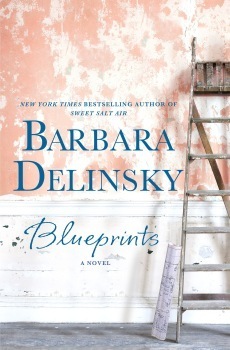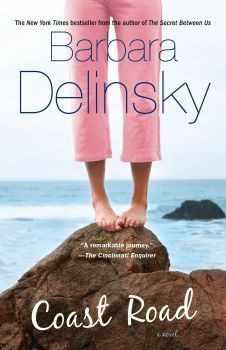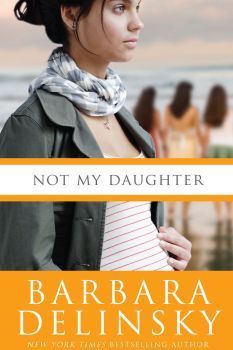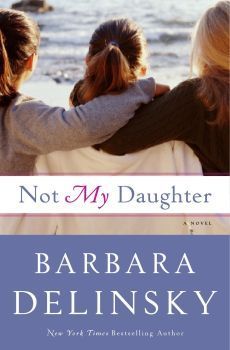Barbara Delinsky's Blog, page 7
June 2, 2015
Barbara’s life plan …
Ha! Do you really think I have a life plan?
Oh, I did once. I assumed I’d have my parents all my life, like every other child I knew. Then my mother died, and reality hit. Believe it or not, I was the only child in my whole third grade class who didn’t have two parents living in the home. Okay. Times have changed. Living with one parent isn’t unusual today. Back then, though, my loss was a huge thing.
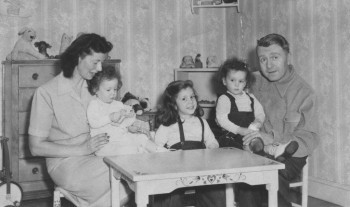
Being without a mother made me self-sufficient and, therefore, independent. It also made me adverse to making long-range plans, and while that may seem sad, it actually opened my mind to possibility. When I went to college, I became Bobbi, not Barbara. I mean, why not try something new? Likewise when I joined a sorority, ran for president of my dorm, got pinned (remember that?) to a really cool guy? I might not have done any of those thing if I’d had a plan.
I didn’t plan on getting a graduate degree, but after I got married, the jobs I was offered didn’t pay enough to support me and a husband in law school. So I fast-tracked a graduate degree and earned more.
I didn’t plan on having kids right away. But I got pregnant. Enough said there.
We waited (carefully) five years to have a second child – didn’t want the expense of two in college at the same time. Then I delivered twins.
I didn’t plan to write. But with three little boys to raise, writing was one of the few jobs I could hold back then that allowed me to work in the home. And then, once I finished my first book, I didn’t plan on making a career of it. But the second book sold, too, and the third, and I just kept going. Suddenly, I had me a career!
Which brings me to Blueprints. This book is about having a plan for life that suddenly doesn’t fit reality. The key to survival, I do believe, is our willingness to keep that open mind and make revisions.
Is any of this resonating with you? Any stories you want to share about your own personal blueprints that had to be changed?
May 29, 2015
Little Loveys
In honor of Mother’s Day earlier this month, I posted a Facebook tribute to my mother along with her picture, and I invited readers to do the same. The response was amazing. The number of people reading the post and sending corresponding tributes to their own moms was heartrending. Their words touched me deeply.
Whether still with us or gone, mothers are our past more than, perhaps, any other person in our lives. And we do cherish the past. It’s part of us. This is why we save old pictures, keep memorabilia in special boxes, and pass heirlooms given to us by our parents on to our children in turn. Prominent in Blueprints is a swatch of Victorian lace taken from Caroline’s mother’s wedding dress. It is framed and hangs on a wall, waiting to be passed down to Caroline’s daughter, Jamie. Like an ink blot, the lace can reflect what the viewer is feeling. It has been part of Jamie’s life forever. She can’t imagine never seeing it again.
In its way, that framed lace is a little lovey – a special something we either look at or touch that relates to our roots and brings us pleasure. I have little loveys. So do my kids. While cleaning my basement recently, I found a carton filled with the stuffed animals that one of my sons, a parent now himself, had loved to bits. From time to time when his kids come over, we go to the basement and they pick an animal to take home. Much as I feel bad for the loveys left in the box, I’m thrilled that some will become active loveys again.
See, I personalize these toy creatures, always have. During my own childhood, when my mother was ill and I needed constancy of loving, my stuffed pets gave it to me. And I loved them back. To this day, I mourn the loss of a Snoopy dog that went to the laundry and never returned. I know these pets are toys, but a part of them are real to me still. Right now, as I write this, it makes me feel so good knowing that the small stuffed kittens in my closet are protecting the ashes of my beloved cat, Chelsea, who died several years ago. Can you see the love that has left its mark on these kitties?

One of my sons had a teeny remnant left from his baby blanket after it had been washed to death. It was a piece of the satin edging of the blanket. When he was, what, four or five, he used to put his thumb in his mouth and rub the satin edging against his face, while he made a little mmmm-mmmm humming sound. We took to calling that little rag his “piece of mmmm,” which kind of captured the sense of contentment that scrap brought him.
Contentment is what it’s about. Comfort. Pleasure. Calm.
How about you? Do you have any gems of your past the bring comfort? Any childhood soothers? Little loveys that you’ve had forever? Post pictures, please!
May 20, 2015
BD and the Big Apple
I used to go to New York a lot. The first time was when I was eleven, when my dad introduced my sisters and me to the place. We stayed at the Commodore Hotel over Grand Central Station, and he took us to the Empire State Building, the Broadway production of “Peter Pan,” Rockefeller Center, and the Flatiron Building. Little did I know at the time that the Flatiron Building would play a role in my life – but I’m getting ahead of myself.
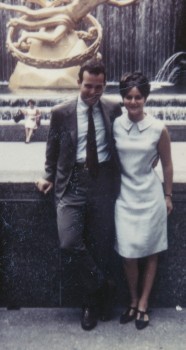 After that maiden trip, there were others to see friends, attend camp reunions, taste more of Broadway (my dad believed in theater), visit museums, even shop. Once I went to college, there were plenty of New York classmates to spend weekends or vacations with. During the whole of my senior year, I was engaged to a guy who was a VISTA volunteer in the South Bronx, so I took the bus to New York once a month.
After that maiden trip, there were others to see friends, attend camp reunions, taste more of Broadway (my dad believed in theater), visit museums, even shop. Once I went to college, there were plenty of New York classmates to spend weekends or vacations with. During the whole of my senior year, I was engaged to a guy who was a VISTA volunteer in the South Bronx, so I took the bus to New York once a month.
Actually, Steve gave me a diamond ring in New York. We went to Rockefeller Center to mark the occasion. Can you believe this picture?
We got married the summer after my graduation and lived in Cambridge, an easy drive to law school for Steve, but we returned to New York whenever we could. Then kids came, I started writing, and Manhattan became something very different for me. It was where I met with my agent, where I met with my publisher, where I went for signings and interviews and author photos.
I don’t go to New York often now. Between phone and email, communication with publishing people doesn’t require constant face-to-face. With the growth of the Internet, book signings have taken a back seat to blog tours. And that author photo? I do it on my home turf.
But I did return to New York last week for meetings with my agent and publisher in advance of the publication of Blueprints, and, let me tell you, I was dreading the visit. A writer spends endless hours in solitude; that’s what I’m used to. But suddenly, I have meetings, one after the other, with anywhere from one to a dozen people, all focused on me. Talk about going outside my comfort zone!
In advance of the trip, I worried that my train would be delayed and I’d be late for meetings, that my performance in a promo video would be inarticulate, or that my clothes would be all wrong. I was worried that I wouldn’t be able to snag a cab to get to the publishing house – which is located in, ta-da, the Flatiron Building, the very same one I first saw when I was eleven – and that my feet would die in heels when I tried to hoof it there. I agonized over forecasts of rain, because rain means humidity, and humidity means frizzy hair, which wasn’t the look I was aiming at.
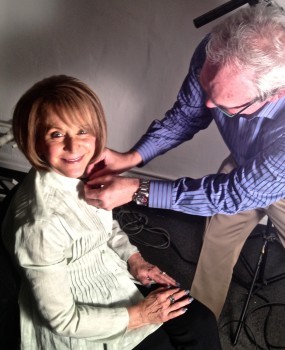
My fears never materialized. Yes, there were sprinkles, but they were minor. The train was on time, I easily caught cabs, and my clothes were perfect. Most important, everyone I met was friendly and sincere and loaded with news of the amazing effort they are putting behind the publication of Blueprints. And then, of course, with such wonderful support, I did just fine with the tapings, both video and audio. Hopefully, I’ll have some samples of those posted where you all can see by the time Blueprints comes out.
That’s June 9. Got it on your calendar?
April 24, 2015
When books mirror life
 I have a childhood friend, living far away now, who swears she knows what’s going on in my life from my newest book. She is certainly right where Blueprints is concerned. During the early months of the writing, in real life I was gutting and redoing the bathroom off my bedroom – totally fitting when the main characters of the book specialize in gut-and-redos.
I have a childhood friend, living far away now, who swears she knows what’s going on in my life from my newest book. She is certainly right where Blueprints is concerned. During the early months of the writing, in real life I was gutting and redoing the bathroom off my bedroom – totally fitting when the main characters of the book specialize in gut-and-redos.
Did one bring the other about? Not really. My husband and I were planning on redoing our bathroom, and the timing just matched. Not that I minded. Not that I mightn’t have even given it a push. When I’m in writing mode, which is a round-the-clock thing, overlap is good.
I’ve done it before. In anticipation of writing Lake News, which was set in a fictitious town in New Hampshire’s Lakes Region, I spent several days with a realtor looking at homes there. My husband and I were in the market for a vacation place, and what better tactic than to kill two birds with one stone? Besides, if you want the lowdown on an area for a book, you won’t find a better resource than a realtor.
We did find our house, and I did write Lake News, which subsequently became the name of our boat. One of my sons commented that first summer that the book had better do well or the boat was a dud.
If that warning applies now, Blueprints will succeed. We love our bathroom. It is spacious and soothing and new. That’s it in the picture above, and you haven’t even seen the soaking tub or the shower! There’s a spa-like something to the room that relaxes us every single day.
Not that it was easy to build. Not that there weren’t glitches and plan changes and times when my husband and I looked at each other and wondered what in the hell we’d been thinking, taking on a project like this. Believe me, I sweated out much of it at the same time that I was sweating out the plot of Blueprints.
Books are intimate things. So are bathrooms, and the one in question is en suite. It was built 27 years ago, when we built the house, and we wanted now to strip it down to the studs. Between the architect, the builder, the interior designer, and our own gluttony, by the time we had final plans in hand, we were stripping and reconfiguring four adjoining closets as well.
Now, I picked my contractor with care, and his crew were honest and clean. But I didn’t want strange men walking into my bedroom at six every morning, which was when they arrived. So my husband and I emptied out those four closets and the bedroom and moved upstairs for four months – four months, for a project that I was promised, promised would take only six weeks.
Okay. There were unexpected glitches. Aren’t there always? Blueprints only go so far. There was the window by the tub that wasn’t up to current code and had to be custom-ordered because the original size was no longer being made. We lost two weeks right there – couldn’t move ahead until the town building inspectors initialed our building permit, which they wouldn’t do until the up-to-code window was installed. There was the pocket door that suddenly needed more space, the heating vents that, ooops, were too deep to function and needed redesign, the wall of mirrors that needed last-minute reconfiguring to avoid breaking. There was the cabinet that arrived without sidebars, and the marble that was cracked during installation. Oh, and did I mention the alarm system that had to be moved by a company that didn’t feel any urgency at all? And through it all there were endless tiny decisions for yours truly to make, like whether the shower door should go all the way to the ceiling or stop eight inches below, which way the medicine chests should open, how long the towel racks should be and where they should be mounted, which light switch should connect to which light.
I swear, writing a book is easier. That said, did the men at work in my house know that I was making notes on what they did and how they did it for the sake of Blueprints? I’m sure they did. I’m also sure that they were flattered. Men usually are. I used to have a dentist who, each and every visit, asked me when I would write a book with a dentist-hero.
Blueprints has construction-heroes. But they’re women. They’re strong and able and honest. And they’re too busy making sure their work is top notch to be wondering how I’ll portray them. I so admire confident, determined, self-deprecating women. You, too?
March 18, 2015
Where’s your comfort zone?

I had a heart-to-heart once with the guy who does my hair. He’d been doing it for a long time, but we were increasingly at odds about style, cut, and color, with him urging me in one direction and my urging him in another. Finally, seeming exasperated, he said, “Barbara, you need to get out of your comfort zone.” I went home and thought about that – and realized that I had been asking him to do my hair differently for months, so that, in fact, he was the one who needed to get out of his comfort zone.
That got me to thinking about comfort zones in general. Work-wise, I’ve often had to operate outside my comfort zone. Blueprints, for instance, is about a home construction company whose women star in a TV reality show. I don’t watch reality TV. It makes me squirm. And the show in Blueprints isn’t of the DWTS ilk. I actually took inspiration for my story from “This Old House,” which is as tame as reality TV goes. But still, I had to leave my comfort zone to watch it, week after week, to understand what it was about.
The same goes for doing research in general. Every book of mine has at least one element in it that I initially know nothing about. Each time I call on a stranger for information, I’m pushing myself. Does that surprise you? I’m an independent, self-sufficient person who has trouble asking for help! But for the sake of my books’ credibility, I have to make those calls, comfort zone or not.
But then, why shouldn’t I push myself? I push my characters, don’t I? Take Blueprints. Avoiding spoilers here, I’ll simply say that Caroline, the 56-year-old mom of my story, steps out of her comfort zone with regard to both sex and work, while Jamie, her 29-year-old daughter, does it with regard to motherhood and true love. Both women grow in the process, and growing is what my books are about.
Growing is what life is about, which means that trying new things, even sometimes taking a risk, is important.
I feel this so strongly that I recently vowed to do one thing, every week, that in some way, shape, or form takes me out of my comfort zone. This could entail my driving on unfamiliar roads at night. Or watching “Homeland.” Or eating octopus salad. Or biting the bullet and banking online.
How about you? If you were to step out of your comfort zone, where would you go?
December 5, 2014
How we got a cover for BLUEPRINTS
If you’re reading this blog, you’re currently looking at the cover of my new book, BLUEPRINTS, which debuts this coming June. What do you think? Does the cover draw you in?
This isn’t an idle question. It’s one that my publisher and I have been asking ourselves since this cover became “the one.” We think it works. But then, we’ve already read the book. You all won’t have read it when you spot the book on sale next June. So will this cover lure you to buy?
In life we’re told not to judge a book by its cover, but that’s exactly what we do when it comes to our reading. The cover sends a message about what’s inside. In that sense, it’s a crucial marketing tool. I’m lucky. My publisher thinks enough of my work to put thought and effort into my covers. Take BLUEPRINTS. We went through numerous renderings of the cover before reaching the one you see here. Along the way, a great deal of time and thought went into not only the BLUEPRINTS storyline, but the fact that the book is coming out in June for summer reading and that the cover of its predecessor, SWEET SALT AIR, was phenomenally successful.
But wait. Let’s back up a little. Readers often assume that the author picks the cover and presents it to the publisher along with the finished manuscript. Nope. I have a say in the final choice, but the cover is the responsibility of my publisher’s art department. As I said above, the cover is a marketing tool, and the folks in the art department are expert marketers. I am not. A case in point was the cover of my non-fiction breast cancer book, UPLIFT. When I first sold it to my publisher, I had very specific ideas of what its cover should be. I wanted something bold and strong and not afraid, since that was what the book was about. I wanted red. That’s bold and strong and not afraid, right? Well, they gave me red, and it looked like blood. After that, I shut my mouth, backed off, and let them do their job.
Their job entails finding a cover that will stand out on the shelves. Sometimes covers come from stock photos – photos that are already in existence and for which the publisher pays a nominal fee. Anything more than nominal, and they’d be just as well creating art for the cover themselves, by hiring either an artist or a photographer. Mind you, stock covers can be beautiful. Unfortunately, if the publisher doesn’t pay for exclusive rights to a photo, it can also appear on the cover of another book. This happened with the trade paperback cover of my book, COAST ROAD. I adored that cover until I saw it several months after the publication of my book on the cover of a competing author’s book.
In the case of BLUEPRINTS, the creative director of the art department listened attentively to my editor as she described the book, then overrode all preconceptions of what a Delinsky cover should be and devised the current one. It is entirely different from those earlier versions. Actually, it’s entirely different from the look that many other summer reads will have. I love this about it. I love the coral cover, which suggests feminine without being girly-girly. I love that the title is hand-drawn, while my name is in the same typeface as it was on SWEET SALT AIR. I love the overall mood here, which is both soothing and suggestive. I love that the in-progress painting job and the roll of blueprints against the ladder suggest the content of the book.
So let’s discuss that content. One of my characters is an architect, hence the blueprints. Home renovation is a backdrop of the book, hence the ladder and paint job. This is a mother-daughter story; does it bother you that there’s no hint of that on the cover? There are also two amazingly hot and heart-filled love stories in the book, but no hint of these either. Should there be? The cover of SWEET SALT AIR was scenic. One of the earlier renditions of the BLUEPRINTS cover was scenic as well. Personally, I felt that a scenic look didn’t work with the title, while this one does.
Naturally, the book cover can’t capture everything. And the front cover blurb covers a multitude of omissions. AND there may be a problem if one of the major account buyers says that he or she hates this cover and will buy far fewer copies of the book if this cover is used. That happened to me with the cover of NOT MY DAUGHTER, in which case my publisher ditched what I thought was a gorgeous and different cover to go with the more trendy girlfriend look. That’s the original on the top and the final beneath it.
All that aside, I happen to think my BLUEPRINTS cover is a winner. What’s your opinion? Yes? No? Maybe?
November 13, 2014
Giving Thanks
Exit polling done during last week’s election shows widespread discouragement and dissatisfaction. And yes, I understand that the economic heyday of the past hasn’t returned. But there’s still much to be grateful for. This is one of the things for which I fault our leaders. Politicians paint a dismal picture of anything and everything as it suits their own goals. As we approach Thanksgiving, though, let’s consider the glass half full. Here are a few ways I do this.
Gas. It’s cheaper than it’s been for a while. Had it been high, we would have been playing the blame game on that. Instead, we just take it for granted. Those of us driving distances this Thanksgiving will definitely feel less of a pinch at the pump.
Weather. Okay. Winter has come earlier than usual this year and likely because of global warming. As contradictory as ‘polar vortex’ and ‘global warming’ sound, scientists do have explanations for it. The good news here? Lightweight down. Jackets and coats made of this are all over the malls, and some are pretty inexpensive. Here’s the one I just bought (click on the image to see where). It’s totally cozy.
The economy. Yes, many people still do not have jobs and, yes, existing wages aren’t climbing. But the stock market has strengthened, and this may affect bosses, who will feel better about things and won’t lay people off. In fact, more jobs are being added each month. The economic rebound may be slow, but it’s happening. Why are we not hearing more about this?
Health care. My neighbors in New Hampshire initially had one insurance carrier to choose from. As of the coming open-enrollment period, they will have five. Moreover, I can personally name ten people in my own state who have affordable insurance for the first time in their lives. They’re pleased, and so am I. The more people – especially young ones, which these ten are – who sign up, the cheaper it will be for us all.
Ebola. Oh, it’s serious. I’m glued to the screen, heartsick watching news reports of the devastation in West Africa. But the international spread that many of us feared appears for now not to be happening. Moreover, extra forces are at work searching for effective treatment and a vaccine.
Holiday safety. Flameless candles. Need I say more?

Food. Clementines are now in season. Yay!
TV. The worst of the new fall shows are starting to be cancelled. And “Downton Abbey” returns in January, “Game of Thrones” in March, and “Outlander” in April.
I’ve forgotten a slew of good stuff, I’m sure. What’s on your list?
September 4, 2014
I have a title!

Book titles arrive different ways. Some crop up at the get-go, even before I start writing a book. Others come when my publisher reads the opening of the book and a word or phrase pops up that is perfect. Others take longer to find.
My preference? I like having a title early on. It helps me focus.
When it came to this new book, which I finished writing this summer, that didn’t happen. My publisher initially liked Feels Like Home. I did not. I liked Home Plans. My publisher did not. One of the problems we had was the dilemma of following up on Sweet Salt Air as a title, which captured smell, taste, and feel, and was a done deal from the start. But this new book, being very different from Sweet Salt Air, needed a very different title. I was adamant about that.
The problem is, a title is a marketing tool. It has to work on many different levels, has to resonate with my publisher’s art, marketing, and sales departments, as well as all of us involved with the book’s contents. To best pick that marketing tool, people in the know have to read it.
I turned the completed manuscript in to my editor in mid-July. She and her assistant read it first, and her assistant generated a list of possible title words. My editor ran through them with me on the phone, reading the list herself for the first time. When she reached one particular word, she stopped, repeated it, and said, “Oh!” I echoed her sentiment exactly.
We both liked it. We found it different and fresh, and it resonated with the story. We checked lists of novels either already published or about to be published, and found it free. Playing devil’s advocate, we wondered whether readers would think the book non-fiction with BLUEPRINTS as the title. But with my name on it? With A Novel printed beneath it? With the kind of cover art we envision? I don’t think so.
The marketing and art departments were immediately excited about the possibilities. Quickly, my editor went back and edited the catalog copy to incorporate this title. Here it is:
BLUEPRINTS is the story of two strong women, Caroline MacAfee, a skilled carpenter, and her daughter Jamie, a talented architect. The day after her 56th birthday, Caroline is told the network wants Jamie to replace her as the host on Gut It!, their family-based home construction TV show. The resulting rift couldn’t come at a worse time.
For Jamie, life changes overnight when, soon after learning of the host shift, her father and his new wife die in a car accident that orphans their two-year-old son. Accustomed to organization and planning, she is now grappling with a toddler who misses his parents, a fiancé who doesn’t want the child, a staggering new attraction, and a work challenge that, if botched, could undermine the future of both MacAfee Homes and Gut It!
For Caroline, hosting Gut It! is part of her identity. Facing its loss, she feels betrayed by her daughter and old in the eyes of the world. When her ex-husband dies, she is thrust into the role of caregiver to his aging father. And then there’s Dean, a long-time friend, whose efforts to seduce her awaken desires that have been dormant for so long that she feels foreign to herself.
Who am I? both women ask, as the blueprints they’ve built their lives around suddenly need revising. While loyalties shift, decisions hover, and new relationships tempt, their challenge comes not only in remaking themselves, but in rebuilding their relationship with each other.
What do you think? Does BLUEPRINTS work for you?
August 21, 2014
Let’s Talk Eggs
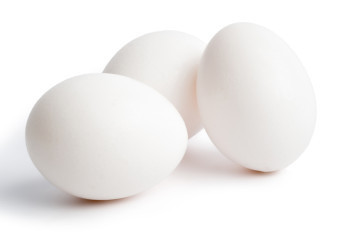 Do you eat ‘em? Not so long ago, we were told to limit our intake. Too much cholesterol, they said! Not healthy, they said! But now, recent studies are showing that the cholesterol in eggs isn’t all bad.
Do you eat ‘em? Not so long ago, we were told to limit our intake. Too much cholesterol, they said! Not healthy, they said! But now, recent studies are showing that the cholesterol in eggs isn’t all bad.
Take a look at this article. Interesting, huh? Clearly, you should eat eggs in moderation, just like you do any other food. Three for breakfast, three for lunch, and three for dinner might not be so good. But one or two a day? That may be okay.
I’ve always loved eggs. I regularly have an egg for breakfast, if not every day, then several times a week. Sometimes I fry it, with oil spray on the skillet. Other times I boil it midway between soft and hard. I don’t poach my eggs – too messy – but I recently had breakfast at a place that did fabulous poached eggs. There are also scrambled eggs, of course. I’ll do this on the weekend; my kids love eggs scrambled with cheese. Toss in whatever leftover veggies are in the fridge, and it’s a meal.
What’s so good about eggs? The best thing for me has less to do with healthy than with staying filled. When I feel empty at ten in the morning and start reaching for food, it doesn’t bode well, diet-wise, for the rest of the day. One egg for breakfast holds me far longer than, say, cold cereal or a muffin.
What else? Well, one egg has a solid 6g of protein, a small 62 mg of sodium, and negligible sugar. All this for 78 calories? Not. Bad.
Another really good thing is that an egg can be eaten for breakfast, lunch, or even dinner. I recently had a totally delicious warm asparagus salad with a fried egg on top for lunch at the Cheesecake Factory, and while not too many restaurants serve eggs for dinner, my personal kitchen does.
What about you? If you eat eggs, how do you like them? I keep a hard-boiled egg or two in my fridge to have on lettuce in a pinch for lunch. Any other ideas?
Scary, our being told so vociferously that eggs were bad for us. It makes you wonder whether five years from now, we’ll be told that some currently highly-recommended food, eaten long term, has a terrifying downside. I suppose that’s the value of ongoing research. Better late than never, eh?
August 6, 2014
Mockingbirds
Just finished my next book! I’ve been working on this baby for more than a year, and that doesn’t count the months before I started the actual writing, when I focused on research. This book – no title yet – demanded a lot of research. I had to learn about the tools a carpenter would keep in her truck, the type of projects she would do, which ones she would like and which ones not, what her hands would look like at the end of the day. I had to learn about an architect’s road to licensure, what her office would look like, and how she might approach a project. I had to learn how a locally-produced, home-renovation tv show might be taped, the prep work that would go into it, and the people who would be on the set. I’m clearly summarizing it for you, but you get my drift.
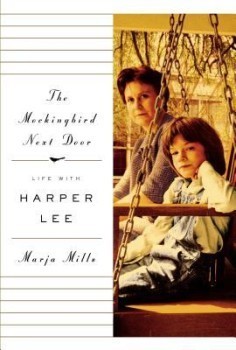 So when I recently picked up a book that had been widely and positively reviewed, I was drawn to it for the way in which the author did her research. The book, which is non-fiction, is The Mockingbird Next Door, by Marja Mills, and its focus is on the life of the very, very elusive Harper Lee, author of To Kill A Mockingbird. Ms. Lee never wrote another book after this one, and, increasingly and insistently, shunned the public eye. How, then, did Marja Mills come to befriend Harper Lee and her sister, Alice, to the extent that she ended up renting the house next door (at Harper Lee’s suggestion, no less) for a time?
So when I recently picked up a book that had been widely and positively reviewed, I was drawn to it for the way in which the author did her research. The book, which is non-fiction, is The Mockingbird Next Door, by Marja Mills, and its focus is on the life of the very, very elusive Harper Lee, author of To Kill A Mockingbird. Ms. Lee never wrote another book after this one, and, increasingly and insistently, shunned the public eye. How, then, did Marja Mills come to befriend Harper Lee and her sister, Alice, to the extent that she ended up renting the house next door (at Harper Lee’s suggestion, no less) for a time?
This was what fascinated me. Oh yes, I was interested in learning about Harper Lee, her town, her friends, and the South, all of which I did. But what most intrigued me, still does, about the book is the quiet, gentle, insightful way the author won the hearts of these women. There was nothing nefarious about it, nothing stealthy. From the start, she was blunt about why she had come to town, but she wasn’t frenetic about it. Afflicted with lupus herself, her lifestyle was, of necessity, more quiet and measured than some. Beyond that, she genuinely enjoyed the sisters and their environs, and respected their needs to a fault.
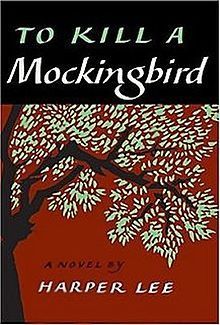
I think back to the research I’ve done, not only on this latest book but on so many others before it. Granted, I never made a source the subject of my book, but simply wanted information about a particular field. Some of my sources were standoffish. Men, especially, were wary. I have a feeling they weren’t sure how what they said would be used in a family-drama-with-love-story-and-sex book. Women were usually warmer. Several became friends and remain so to this day. In all these instances, I have utmost respect for my source and his or her work. I never pay sources, other than to name them in my Acknowledgment page and, when the book is published, send them a signed hardcover copy. Some send me thank you notes in return; others do not. I like to think that those who read the actual book felt good about their part in it.
So. Where is my book right now? It’s in the hands of my editor, who loved it, to my relief, and will now “mark it up” with small edits. She wants me to add three brief scenes, which I’ll do at the same time that I incorporate her edits into the manuscript. And that title we don’t have? It’s coming. I’ll let you know as soon as we zero in on the one.
In the meantime, I do recommend The Mockingbird Next Door. Do you ever read non-fiction? If so, are there any books you want to recommend?

